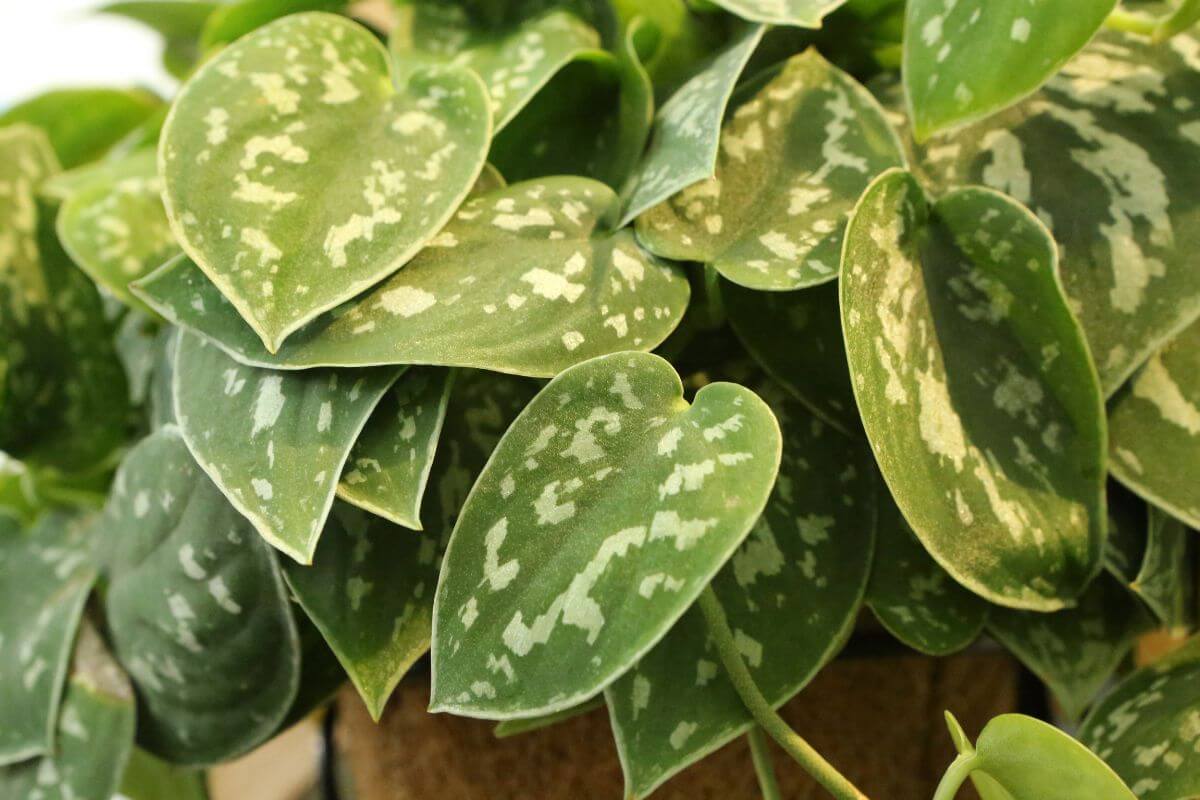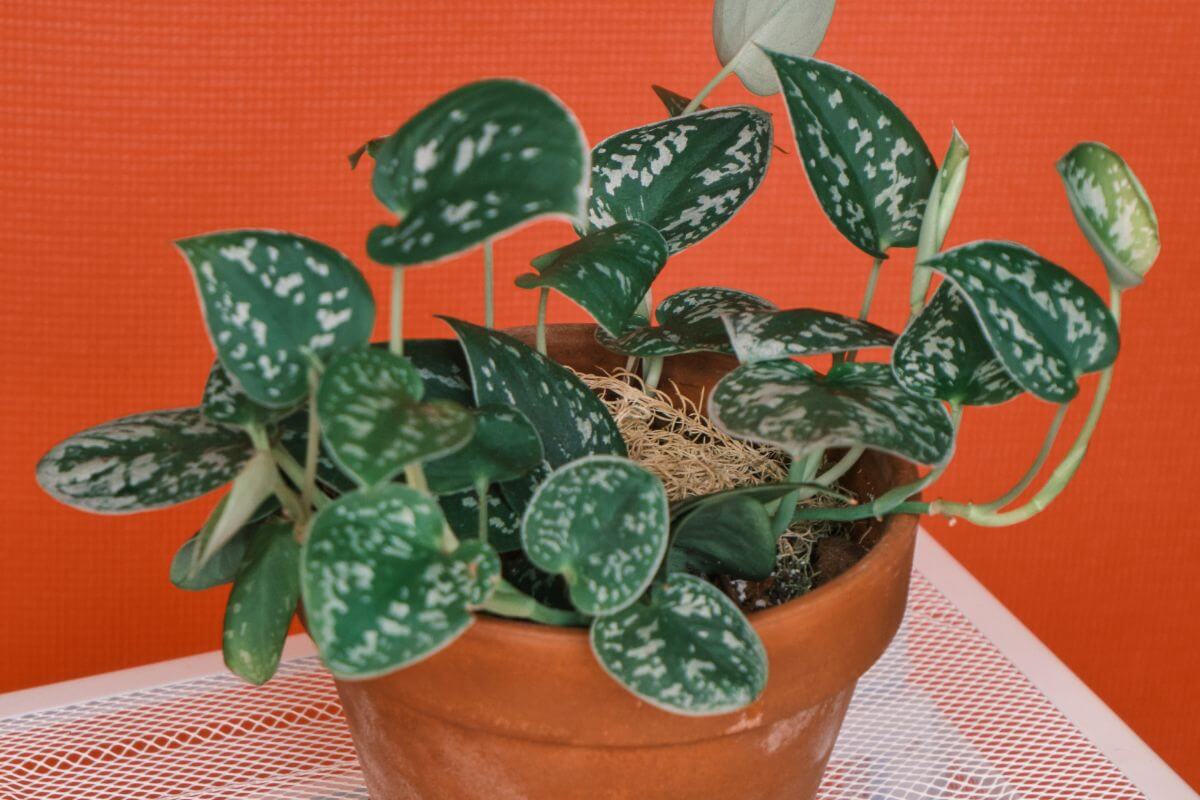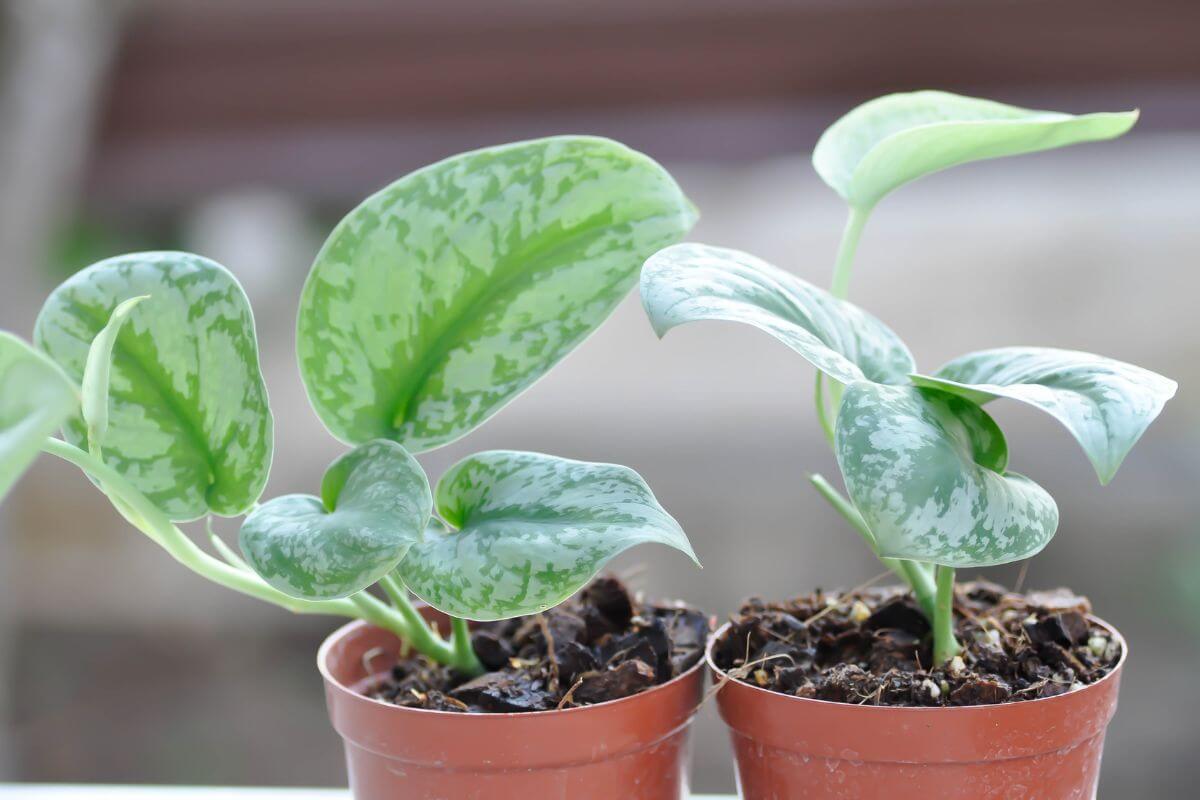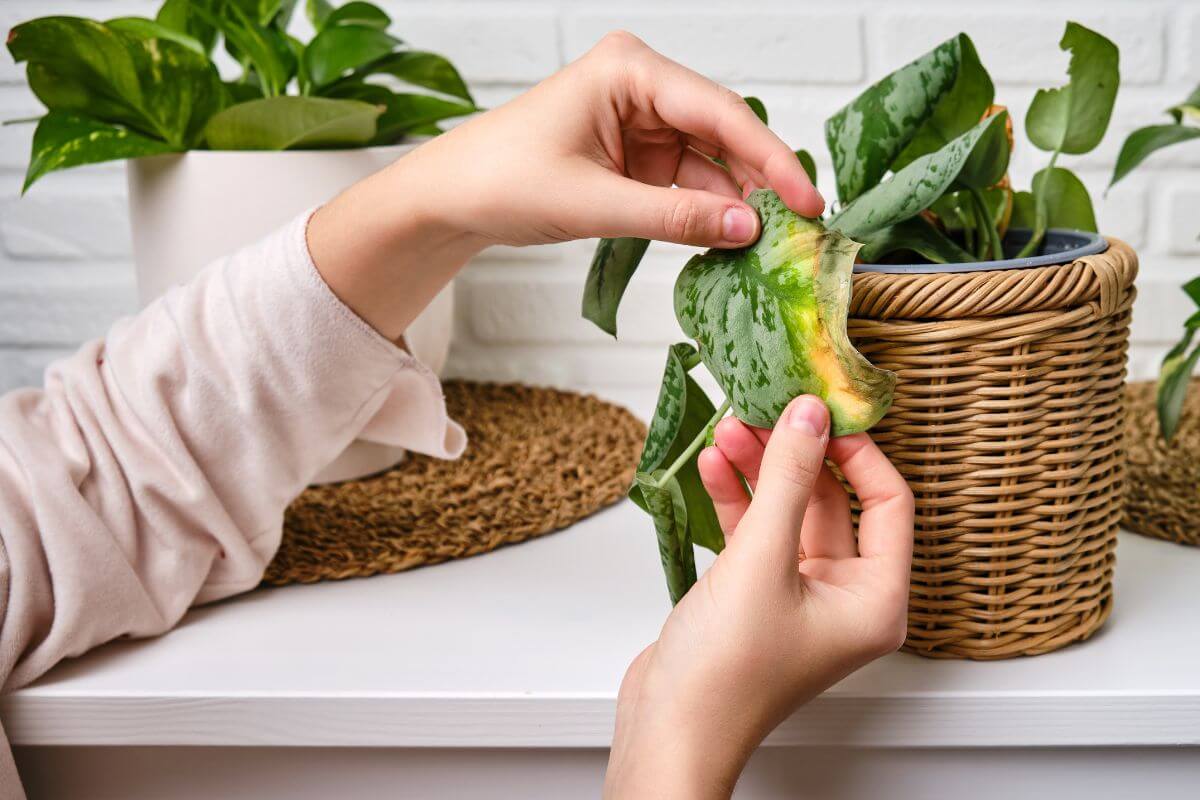Silver satin pothos plants are beautiful, low maintenance houseplants that require minimal care. They thrive indoors year round and are perfect for beginners looking to add an indoor plant to their home.
If you’re new to gardening, then you might want to start out with a simple houseplant first. A silver satin pothos plant is a great choice because it’s easy to grow, requires minimal care, and looks lovely in any room.
Silver Satin Pothos Plant Overview

The Scindapsus pictus is better known as the Silver Satin Pothos, or more simply named as the Silver Pothos or Satin Pothos.
Its natural habitat is the Asian tropical rainforests. This lovely plant boasts a type of bluish-green hue with silver patterns on leaves with a matte finish.
Traditional pothos foliage is glossy and this distinguishes it from other pothos houseplant varieties. In fact, “pictus” means painted in a reference to the silvery designs that set it apart.
Often it is referred to as the Silver Philodendron, but this is a common pothos vs philodendron plant misconception.
Like both the Philodendron and the popular Golden Pothos, the silver satin is a trailing vine plant that looks great in hanging baskets, or positioned on a high shelf or tall piece of furniture.
Silver satin vines can grow as long as ten feet long in their native habitat, but indoors they will grow to about three feet. It has heart-shaped leaves, but tend to be smaller than the more common golden pothos.
This tropical plant is a slow grower, but with a bit of patience, it will reward you with a striking cascade of foliage or as a climber, depending on which you prefer.
You can also choose to prune them to create a fuller stand-up plant if you prefer that type of potted plant more.
The Scindapsus pictus does not belong to the Epipremnum genus as most other well-known pothos varieties. In the past, the silver satin pothos was included in the Epipremnum genus, so when it was reclassified, the common name Pothos remained.
The Scindapsus pictus does have a variety of cultivars, among which you may find:
- Argyraeus which features less variegated leaves.
- Exotica which features more variegation resembling patches or splotches.
- Silver Ann features silver in its leaf color.
Silver Satin Pothos Plant Care Guide
Soil for the Silver Satin Pothos

The silver pothos needs well-draining soil, so a good quality potting soil that is loose and doesn’t retain water is the best choice. Your Scindapsus pictus will also need a nice pot with several drainage holes to facilitate draining.
You can blend your own growing medium by mixing equal parts of perlite, peat moss and potting soil. The perlite will help with drainage, while the potting soil offers nutrients, and the peat moss maintains some moisture for the root ball.
Keep in mind that if the soil bed drains the water very quickly, you may need to add more moss or water more frequently. If it does not drain well, the soil may need aeration because it is compacted.
Temperature for the Silver Satin Pothos
Average temperatures for your silver satin should sit between 65° and 85°F. The minimum temperature of 60°F is important to keep the silver pothos plant healthy. Keep the plant away from cold drafts.
It can be moved outdoors, especially in warmer climates, as long as it gets indirect light and not direct sunlight exposure. Decks and porches are a great location.
Light for the Silver Satin Pothos

The silver satin loves lots of bright indirect sunlight. Windows that face east or west are ideal as sun exposure should be early morning or late afternoon. Be careful placing this plant where it receives direct light as this can burn the leaves.
Like other pothos or even philodendrons, it will adapt to low-light conditions. The problem will be that with limited light, it will become leggy with sparse foliage on its vines.
The silver variegation may also start fading a bit. A telltale sign of a lack of light will be if the foliage darkens.
To encourage growth, leaf variegation, and the plant’s general health, try moving it to a sunnier, brighter position where it will get plenty of light.
Water for the Silver Satin Pothos
When the top inch of the soil bed is dry, you need to water your plant. Putting your finger into the soil is a quick test.
During the summer, you may need to water the silver pothos every three to four days. In the winter months, watering can be reduced as long as the soil and root ball remain moist.
As these plants can be sensitive to tap water and potential minerals, filtered water or rainwater is recommended. You can soak your silver satin allowing the plant to drain thoroughly.
Humidity for the Silver Satin Pothos
The silver satin likes medium to high humidity levels that are around 40%. A humidifier or pebble tray underneath the silver satin will help if your home is usually dry.
A tray filled with pebbles water placed underneath is a good solution. The silver satin pothos should not come into contact with the water to avoid root rot.
You can also place the silver satin pothos in a group with other plants, or place a container of water near the plant. While misting helps, it will not resolve humidity problems for the long term.
Fertilizer for the Silver Satin Pothos
Feed your silver satin pothos monthly with a liquid fertilizer diluted to half-strength during the growing season. Avoid fertilizing in the winter as the plant is dormant.
Pruning the Silver Satin Pothos
The silver satin pothos does not really need pruning, but you can encourage fuller growth by trimming vine tips. Remove dead leaves and stems if they become too long.
Propagating the Silver Satin Pothos
The easiest way to propagate the silver pothos is by placing stem cuttings in water.
Once new roots have developed to about an inch in length, you can transfer them to a potting soil mix.
Repotting the Silver Satin Pothos

Silver satin pothos plants can be repotted annually in the springtime. Fresh potting soil will help provide nutrients for the plant.
When repotting, move to the next larger pot size to give the roots more room. Signs that it is time to repot include poor drainage with compacted soil, very slow growth, and roots that grow out from the drainage holes.
Silver Satin Pothos Toxicity and Pets
The silver satin pothos is toxic to animals like cats, dogs, and horses. The plant contains calcium oxalates that can lead to vomiting, difficulty swallowing, swelling, and other oral symptoms if ingested.
Silver Satin Pothos Problems, Pests, and Diseases

Root disease is one of the most common problems for the satin pothos and the reason is usually from overwatering.
To prevent overwatering, only water when the top 1-2 inches of the soil is dry.
To try and save your plant from root rot, you can remove the old soil, trim away any damaged black roots, and repot in a fresh soil mix. Do not water until the plant is partially dry.
Pests to be on the lookout for include spider mites and scale. Scale insects can be removed by hand. To remove the spider mites, give your plant a good spray or shower.
Afterward, treat the plant with an organic insecticidal soap or neem oil to prevent future pest infestations.
Silver Pothos Care Final Thoughts
The silver satin pothos is easy to care for and has a beautiful appearance. It is a great addition to any indoor garden.
For other varieties of pothos plants, here are a few other care guides:
- Overview of Pothos Varieties
- Marble Queen Pothos Care Guide
- Neon Pothos Care Guide
- Cebu Blue Pothos Care Guide
Silver Pothos FAQs
Is the silver satin pothos rare?
The silver satin pothos is not rare and is one of the most popular indoor plants for home decor. These plants are easy to grow and care for. They are readily found at nurseries or garden centers, so you won’t need to worry about not finding one.
Why is silver pothos dying?
The silver pothos could be dying for a number of reasons. Overwatering and underwatering are common reasons that they could be dying. They need regular watering to thrive, without having soggy soil.
Is silver pothos a philodendron?
No, the silver pothos is not a philodendron. The silver philodendron is very similar to the silver pothos with their heart-shaped leaves, silver variegation, and long vines. But they are actually from different plant species.
Is Silvery Ann the same as silver pothos?
No, the Silvery Ann and the Silver Pothos are different plants with their leaves being the main difference. The Silvery Ann has more variegation in its leaves, but the leaves are smaller than the silver pothos.
Silver pothos vs satin pothos?
The silver pothos and satin pothos refer to the same plant. There’s no difference between them, except for its name. They both feature silver variegated, heart-shaped leaves and long, flowing vines.
Why are satin pothos leaves turning yellow?
The satin pothos leaves turn yellow because they’re stressed from too much water in the soil. Be sure to have excellent drainage in the potting mix and the pot. Other reasons the leaves are turning yellow could be because of underwatering, a pest infestation, and/or nutrient deficiencies.
Why are silver satin pothos leaves turning brown?
Silver satin pothos leaves turn brown when they are exposed to too much sunlight, low humidity, or over-fertilization. Place the plant in indirect light, so the leaves don’t dry and scorch. Mist the leaves for short-term humidity relief, but it’s best to add a humidifier to the room to increase humidity levels. Giving it too much fertilizer will also turn the leaves brown.
Why are my satin pothos leaves curling?
Satin pothos leaves curl when they dry out. Water evaporates from the leaf surface faster than it can be replaced by new water. When the plant dries out, the leaves shrink, causing them to curl up into a tight ball. To prevent this problem, add a small amount of water each week until the plants start growing again.
Is the silver pothos air-purifying?
Yes, the silver pothos is known for its ability to purify the air, and it can help reduce allergies and respiratory infections. Pothos plants also produce natural insecticides. They can be found growing indoors and out, and they thrive in soil that drains well.

